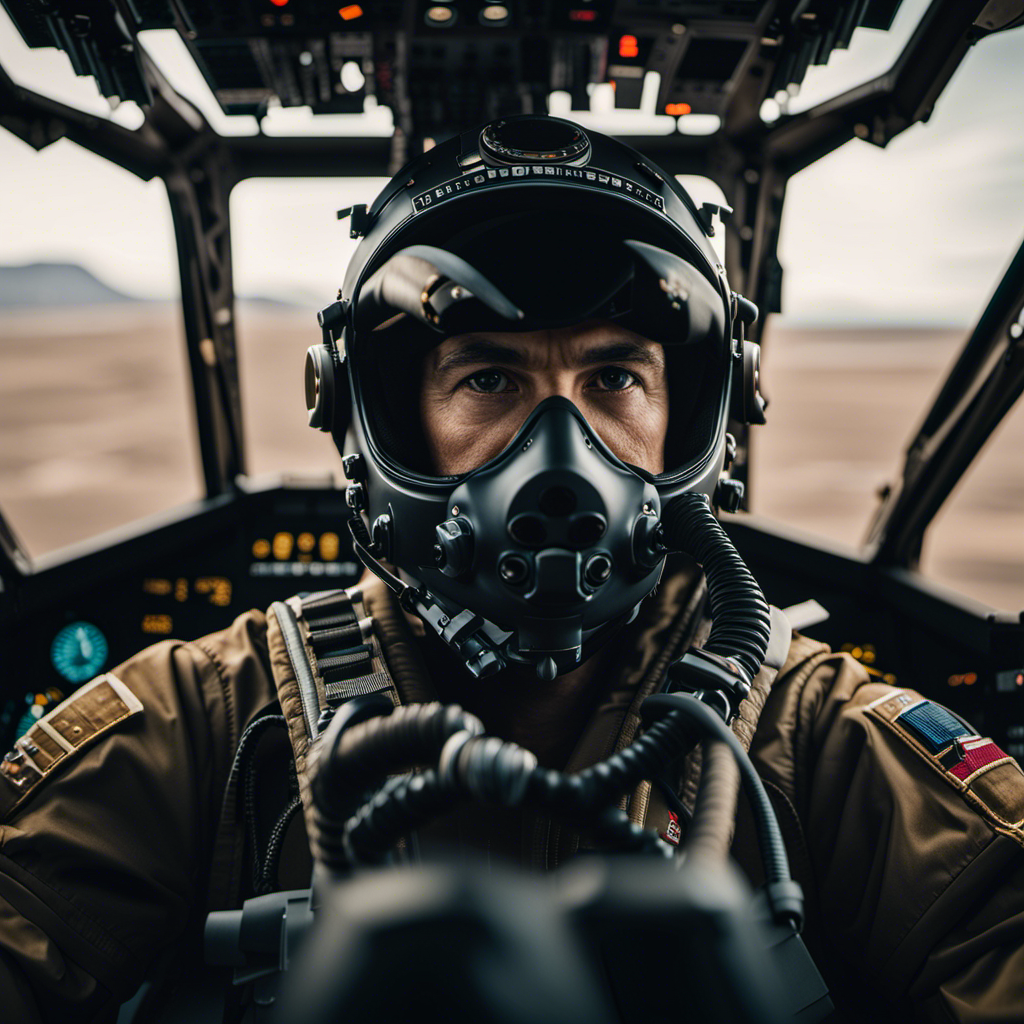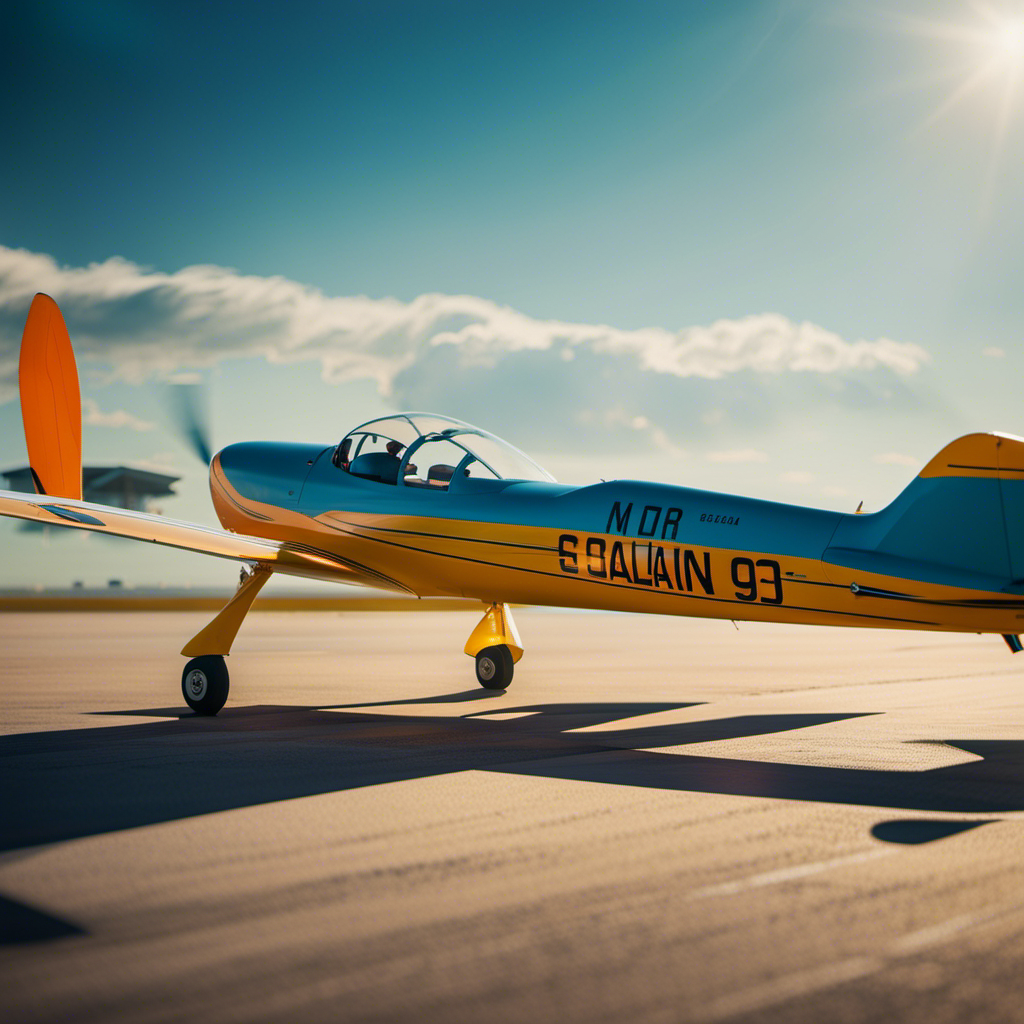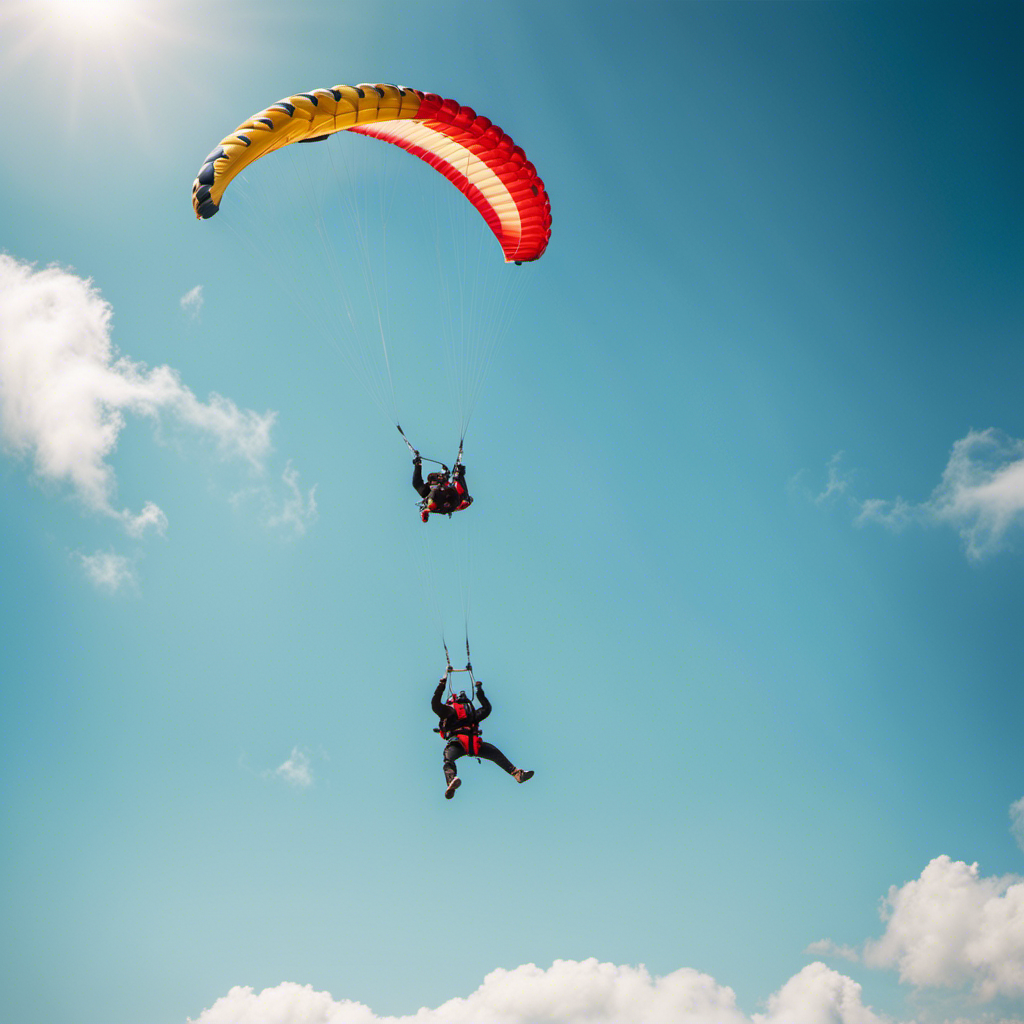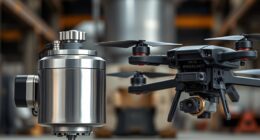Does the saying, ‘birds of a feather flock together,’ suggest that they also fly or glide together in harmony?
In this article, I will delve into the mechanics of avian flight and explore the difference between soaring and gliding.
We will examine how birds utilize air currents to stay aloft, the role of wing shape and size in flight techniques, and the importance of feathers and wing morphology in their maneuvers.
Join me as we unravel the evolutionary origins and fascinating world of soaring and gliding in birds.
Key Takeaways
- Soaring uses rising air currents for lift and energy efficiency
- Gliding requires birds to generate their own lift
- Soaring relies on external sources of energy, while gliding relies on internal generation
- Soaring is more energy efficient compared to gliding
The Mechanics of Avian Flight
You can understand the mechanics of avian flight by studying how birds soar or glide. Wing flexibility plays a crucial role in their ability to achieve lift and maneuver through the air. The wings of birds are designed to generate aerodynamic forces that counteract gravity and propel them forward.
The flexibility of their wings allows for adjustments in shape and angle, enabling efficient lift production. By changing the curvature of their wings, birds can control the generation of lift and adjust their flight path. Additionally, the varying speeds and angles at which birds fly contribute to their ability to soar or glide.
Understanding the intricate relationship between wing flexibility and aerodynamic forces provides insights into the fascinating world of avian flight.
Now, let’s explore the difference between soaring and gliding.
The Difference Between Soaring and Gliding
Flying through the air, it’s important to understand the distinction between soaring and gliding. Soaring is a type of flight where birds use rising air currents, such as thermals or updrafts, to gain altitude and maintain their position in the air. Gliding, on the other hand, is a form of flight where birds use their wings to generate lift and travel horizontally without flapping. The physics behind soaring and gliding are quite different. Soaring relies on external sources of energy, such as air currents, to provide lift and reduce the energy expenditure of the bird. Gliding, on the other hand, requires the bird to generate its own lift by manipulating its wings and body position. This makes soaring more energy efficient compared to gliding.
To illustrate this difference, consider the following table:
| Soaring | Gliding | |
|---|---|---|
| Energy | External sources | Internal generation |
| Efficiency | High | Low |
As the table demonstrates, soaring is more energy efficient because it utilizes external forces, such as air currents, to maintain flight. Gliding, on the other hand, requires birds to generate their own lift, resulting in a higher energy expenditure.
Understanding the distinction between soaring and gliding is crucial in comprehending how birds utilize air currents to stay aloft.
How Birds Use Air Currents to Stay Aloft
By utilizing air currents, birds are able to stay aloft and maintain their position in the sky. One way they do this is through wing flapping, which generates the necessary lift to counteract gravity. Flapping their wings allows birds to create thrust and generate forward movement, enabling them to maneuver in the air.
However, wing flapping requires a lot of energy, so birds have evolved other strategies to conserve energy while staying airborne. One such strategy is taking advantage of thermal updrafts, which are columns of warm air that rise from the ground. By soaring in these updrafts, birds can gain altitude and stay aloft without expending as much energy. This allows them to cover long distances efficiently and conserve their energy for other activities.
Transitioning into the subsequent section about wing shape and size in relation to flight techniques, birds have adapted various wing shapes and sizes to optimize their flight abilities without relying solely on wing flapping.
Wing Shape and Size in Relation to Flight Techniques
To optimize your flight techniques, consider the wing shape and size that best suits your needs.
The wing span and shape play a crucial role in determining the flight speed and efficiency of birds. Birds with longer wings have a greater wing span, which allows them to generate more lift and soar effortlessly through the air. On the other hand, birds with shorter wings are better suited for quick and agile flight, as their reduced wing span minimizes drag and allows for faster maneuvering.
Additionally, the shape of the wing, whether it is rounded or pointed, affects the bird’s ability to generate lift and control its flight. By understanding the relationship between wing shape, size, and flight speed, birds can adapt their wing morphology to suit their specific needs.
Now, let’s explore the role of feathers in flight.
The Role of Feathers in Flight
When it comes to feathers, you’ll be amazed at how they contribute to your ability to maneuver and control your flight.
Feather structure plays a vital role in flight adaptations of birds. Each feather is composed of a central shaft, known as the rachis, which supports a series of barbs. These barbs are further divided into smaller structures called barbules, which interlock with each other to form a strong and flexible surface.
This arrangement allows birds to adjust the shape and angle of their feathers, altering their wing’s surface area and creating lift. Moreover, the lightweight nature of feathers enables birds to stay airborne for extended periods without expending excessive energy.
With this understanding of feather structure and flight adaptations, we can now explore how birds adjust their flight patterns in different environments, seamlessly adapting to the challenges they encounter.
How Birds Adjust their Flight Patterns in Different Environments
Transition: Now that we have explored the role of feathers in flight, let’s delve into how birds adjust their flight patterns in different environments.
Current Subtopic: Birds have remarkable adaptations that allow them to navigate and thrive in windy environments. These adaptations are crucial for their survival and success in flight. Here are some key points to consider:
- Streamlined body shape: Birds have evolved streamlined bodies that reduce drag and allow for efficient flight in windy conditions.
- Flexible wings: The flexibility of bird wings enables them to adjust their shape and angle of attack, optimizing lift and maneuverability in gusty winds.
- Wing loading: Birds with lower wing loading, or the ratio of body weight to wing area, have a distinct advantage in windy environments as they can generate more lift.
The impact of climate change on bird flight patterns is a growing concern. With increasing wind speeds and unpredictable weather patterns, birds may face challenges in maintaining their flight patterns and navigating their migratory routes.
Transition: Understanding the influence of wing loading on flight techniques is essential in comprehending how birds adapt to changing environmental conditions.
The Influence of Wing Loading on Flight Techniques
You’ll notice that wing loading plays a significant role in how birds adjust their flight techniques in different environments. Wing loading refers to the amount of weight carried by a bird’s wings relative to its size. It is calculated by dividing the bird’s weight by the total wing area. Birds with higher wing loading have more weight to carry and tend to have faster flight speeds but lower maneuverability. On the other hand, birds with lower wing loading can achieve slower flight speeds and higher maneuverability. This is because lower wing loading allows for a greater lift-to-drag ratio, resulting in improved flight efficiency. The effects of wing loading on flight techniques can be summarized in the following table:
| Wing Loading | Flight Speed | Maneuverability |
|---|---|---|
| High | Fast | Low |
| Low | Slow | High |
Understanding how wing loading affects flight techniques is essential to comprehend the different strategies birds employ to soar and glide through the air.
Examples of Birds that Soar
To identify birds that excel at soaring, take a look at species like eagles and vultures. These magnificent creatures are known for their ability to efficiently utilize rising air currents to maintain flight. One common method of soaring is by utilizing thermals, which are columns of warm air that rise from the ground. Birds in thermals can effortlessly gain altitude by circling within these upward-moving pockets of air.
Additionally, birds in coastal areas often take advantage of onshore winds and sea breezes to aid their soaring flights. These winds provide a consistent source of lift, allowing birds to effortlessly glide along the coastline.
By understanding the strategies employed by birds that soar, we can gain insight into the remarkable adaptability and efficiency of these avian creatures.
Moving on to examples of birds that glide…
Examples of Birds that Glide
Birds like albatrosses and frigatebirds effortlessly ride air currents as they soar through the sky. However, not all birds soar; some birds rely on gliding to navigate their environment.
For example, the Red-tailed Hawk, a common raptor in North America, is known for its ability to glide for long distances. By extending its broad wings and using updrafts and thermal currents, the Red-tailed Hawk can cover great distances without flapping its wings.
Similarly, the White-throated Needletail, a swift found in Europe and Asia, is a master glider. It can reach astonishing speeds while gliding, making it one of the fastest birds in level flight.
Understanding the examples of birds that glide is crucial to comprehending the benefits and drawbacks of soaring and gliding in avian locomotion.
The Benefits and Drawbacks of Soaring and Gliding
Understanding the examples of birds that glide can provide insight into the advantages and disadvantages of soaring and gliding as methods of avian locomotion.
Soaring, characterized by sustained flight using rising air currents, offers significant energy efficiency for birds. By utilizing updrafts and thermal currents, birds can minimize the amount of energy expended during flight, allowing them to travel long distances with minimal effort.
On the other hand, gliding, which involves short bursts of flight without flapping, offers greater maneuverability. Gliding allows birds to navigate through narrow spaces, change directions quickly, and make precise landings. However, gliding requires more energy because it relies on the initial force generated by flapping wings.
Understanding the trade-offs between energy efficiency and maneuverability can help us appreciate the different strategies birds employ in their flight techniques. This knowledge transitions us into the subsequent section about how birds adapt their flight techniques for hunting and foraging.
How Birds Adapt their Flight Techniques for Hunting and Foraging
When hunting and foraging, birds adapt their flight techniques to efficiently locate and capture prey. They employ a variety of bird hunting techniques and foraging adaptations that allow them to navigate different environments and exploit various food sources.
One common technique is the aerial hover, where birds remain stationary in mid-air while scanning the ground for potential prey. Another technique is called stooping, where birds dive rapidly from a height to surprise and catch their prey. Additionally, some birds use soaring and gliding to cover large distances while conserving energy.
These adaptations in flight techniques enable birds to optimize their foraging efforts and increase their chances of obtaining food. Understanding the different hunting and foraging strategies of birds provides valuable insights into their ecological roles and survival strategies.
Transitioning into the next section, the role of wing morphology in flight techniques is a fascinating area of study.
The Role of Wing Morphology in Flight Techniques
As we explored how birds adapt their flight techniques for hunting and foraging, it is important to delve into the role of wing morphology in these maneuvers. The shape and structure of a bird’s wings are crucial for its flight efficiency and maneuverability.
The size of the wing and the ratio of its length to width greatly impact the bird’s ability to soar or glide. The shape of the wing, such as its curvature and the presence of specialized feathers, determines the bird’s maneuverability in the air. The arrangement and movement of the wing bones and muscles also contribute to the bird’s flight techniques.
The Role of Tail Feathers in Flight Maneuvers
To fully grasp the role of tail feathers in flight maneuvers, you should examine their shape, size, and arrangement on a bird’s tail. Tail feather adaptations play a crucial role in enhancing flight maneuverability for birds.
The shape of the tail feathers affects the bird’s stability and control during flight. For example, birds with forked tails, like swallows, have increased maneuverability due to their ability to quickly change direction.
Additionally, the size of the tail feathers contributes to the overall balance of the bird, allowing for precise movements. The arrangement of the tail feathers also influences flight maneuverability.
Birds with a fan-shaped tail, such as peacocks, can use their tail feathers as a display during courtship, but they may sacrifice some maneuverability.
Understanding the intricate relationship between tail feather adaptations and flight maneuverability is essential in comprehending how birds learn to soar or glide effortlessly through the air.
How Birds Learn to Soar or Glide
Birds can learn to effortlessly soar or glide through the air by observing and imitating the flight techniques of other birds. This ability to learn from each other’s flight techniques allows birds to adapt and optimize their own flight patterns.
One important aspect of birds’ flight techniques is the optimal wing shape. Different bird species have evolved distinct wing shapes that are specialized for their specific flight styles. For example, birds that soar for long periods of time have long, broad wings that allow them to catch thermals and glide effortlessly. On the other hand, birds that glide in short bursts have shorter, more rounded wings that provide better maneuverability.
The Evolutionary Origins of Soaring and Gliding in Birds
By observing and imitating flight techniques, I can gain insights into how birds evolved to soar and glide effortlessly through the air. Soaring and gliding are two distinct forms of aerial locomotion that have evolved in birds as evolutionary adaptations.
Soaring involves using rising air currents and thermals to stay aloft without flapping their wings, while gliding involves using the momentum gained from a previous flight to maintain altitude and cover longer distances.
These abilities have likely evolved over millions of years, allowing birds to efficiently navigate their environments and conserve energy. Various anatomical and physiological adaptations, such as large wingspans, streamlined bodies, and specialized feathers, contribute to their mastery of aerial locomotion.
Frequently Asked Questions
How do birds adjust their flight patterns in different environments?
Birds adjust their flight patterns in different environments by utilizing various strategies. In urban environments, they navigate obstacles by maneuvering swiftly and flying at lower altitudes. In open landscapes, they take advantage of thermals for soaring and gliding to conserve energy.
What are the benefits and drawbacks of soaring and gliding for birds?
There are several benefits to soaring and gliding for birds. Soaring allows birds to conserve energy by using natural air currents, while gliding enables them to cover long distances efficiently. However, there are drawbacks as well, such as the need for favorable weather conditions and the potential risk of collisions with other birds or obstacles.
How do birds adapt their flight techniques for hunting and foraging?
Birds adapt their flight techniques for hunting and foraging by employing various adaptation techniques. They use precise aerial maneuvers, such as hovering, diving, and rapid changes in direction, to locate and capture prey.
How do birds learn to soar or glide?
Birds learn to soar or glide through a process called bird flight training. They develop the necessary skills and techniques to utilize air currents and thermals effectively, allowing them to stay aloft for extended periods and cover long distances.
What are the evolutionary origins of soaring and gliding in birds?
The evolutionary origins of soaring and gliding in birds can be attributed to the evolutionary advantages they provide. By utilizing air currents, birds are able to conserve energy and access new ecological niches.
Conclusion
In conclusion, understanding the mechanics of avian flight is crucial in comprehending the difference between soaring and gliding.
Through the use of air currents, birds are able to stay aloft and navigate their surroundings. Wing shape and size, as well as the role of feathers and wing morphology, play significant roles in their flight techniques.
Interestingly, studies have shown that some birds can travel long distances without flapping their wings, gliding effortlessly for over hundreds of miles. This statistic paints a vivid picture of the incredible abilities of birds in flight.









